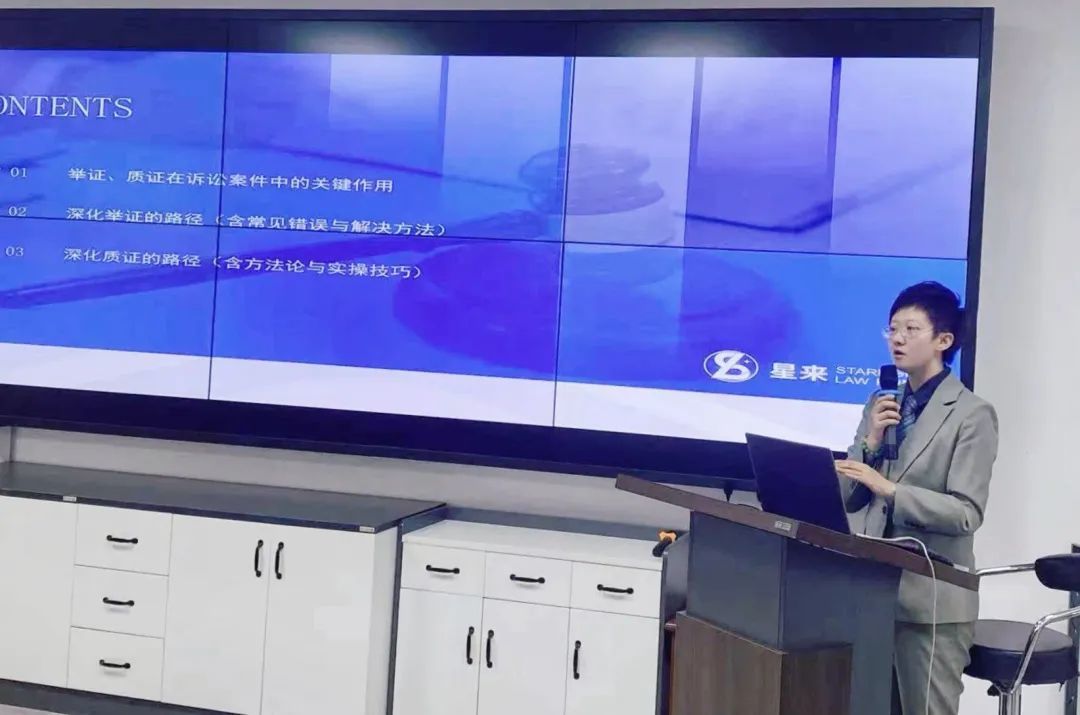
Editor's Note
To enhance the practical skills of lawyers and the legal community, Jilin Yuzhongren Law Firm recently joined forces with the Jilin Alumni Association of China University of Political Science and Law to successfully host a Legal Practice Seminar. The event focused on two key themes: "Mastering Civil Litigation Rules to Strengthen Lawyers' Courtroom Advocacy Skills" and "Improving Litigation Outcomes Through Deepening Evidence Presentation and Cross-Examination." Renowned legal experts, scholars, and practitioners were specially invited to participate in the insightful discussions.
Du Jiahong, founding partner and Director of the Corporate Practice Center at Beijing Xinglai Law Firm, attended the conference as a special guest. Drawing on her extensive practical experience, she shared strategies and techniques for deepening evidence presentation and cross-examination—key steps to enhancing litigation outcomes—providing attendees with invaluable hands-on guidance. The following content is compiled and published based on her insights shared during the event.

Du Jiahong, Founding Partner and Director of Corporate Practice at Beijing Xinglai Law Firm
I. The Critical Role of Evidence Presentation and Cross-Examination in Litigation Cases
In litigation cases, presenting evidence and challenging the opposing party's evidence are central to establishing the facts and determining the outcome of the lawsuit. The determination of facts relies entirely on the support of evidence—without evidence, there can be no facts, and if the facts remain unclear, it becomes difficult for the judge to reach a fair decision. Therefore, presenting and questioning evidence is not only a critical tool for lawyers to prove the facts and persuade the judge but also a key factor influencing the judge’s subjective assessment of the case. By effectively presenting and cross-examining evidence, lawyers can guide the judge’s attention to the core issues at hand, potentially shaping the judge’s decision in their client’s favor.
II. Deepening the Path of Evidence Presentation
1. Dynamically organize the evidence: During the period from filing a case to the court hearing, lawyers should continuously review and analyze the case to uncover new evidence. For instance, in a contract dispute case, by re-examining bank statements, they discovered crucial evidence revealing the other party’s hidden assets. This underscores the importance for lawyers to maintain a keen awareness of their cases and engage in reflective, iterative thinking—avoiding the "one-time" approach to evidence gathering.
2. Comprehensive and Precise Evidence Presentation: Lawyers should present comprehensive evidence while avoiding the "cumulative accumulation of irrelevant proof." For instance, in a certain loan dispute case, by supplementing the court with evidence demonstrating the creditor's claims from external sources, the tribunal was better able to consider the case's broader social implications—ultimately leading to a successful verdict. When presenting evidence, it’s crucial to balance thoroughness with precision.
3. Use cross-examination thinking to reverse-engineer evidence presentation: When presenting evidence, lawyers should anticipate the opposing party's potential challenges and proactively strengthen their own case by supplementing key pieces of proof. For instance, in a recent trade dispute, attorneys successfully identified subtle inconsistencies within their own evidence by simulating courtroom cross-examinations—essentially "fighting it out" on both sides of the argument. This approach helped them avoid being caught off guard during the actual trial. It underscores the importance of approaching evidence presentation with an adversarial mindset, ensuring that your arguments are solidly backed by robust, well-prepared evidence.
4. Highlight key facts to the judge: Lawyers should emphasize key facts to the judge during the evidence presentation phase. It’s crucial for lawyers to fully leverage this opportunity, using both verbal communication and the way evidence is presented to highlight and effectively convey critical, compelling proof.
5. Clearly define the evidentiary purpose of the evidence: When presenting evidence, lawyers must ensure that the content of the evidence closely aligns with the purpose it seeks to prove. In many cases, however, the evidence fails to connect effectively with the intended purpose, easily leaving the court with an unprofessional and unfavorable impression. Therefore, lawyers need to possess strong evidence-analysis skills to prevent their professional image from being undermined by unclear or ambiguous proof objectives.
6. Actively apply to request the submission of evidence: In this case, much of the crucial evidence is inaccessible to the lawyer and can only be obtained through court-ordered investigations. Therefore, lawyers should actively exercise their right to request court-issued evidence-gathering measures. In some instances, the process of applying for such evidence can even provide valuable insights into how the trial may unfold. For example, in a loan dispute case, our side presented court documents as part of our evidence to establish that the opposing party was a professional lender. We also requested the court to gather additional supporting evidence. Interestingly, the bench appeared particularly sensitive to the issue of "professional lending" and conducted a thorough review—but ultimately rejected our request for further evidence. Based on this outcome, we were able to anticipate that the court likely concluded the existing evidence was sufficient to substantiate the claim of professional lending. Sure enough, the final verdict aligned precisely with this assessment.
III. Deepening the Path of Cross-Examination
1. Seize the opportunity to present evidence in court: When confronted with a surprise evidentiary challenge, lawyers should strive to cross-examine in court to strengthen their argument and enhance their persuasive impact. Cross-examining in court is a crucial opportunity to demonstrate professional expertise.
2. Closely monitor the details of the evidence: Lawyers must carefully examine the evidence to identify inconsistencies in the opposing party's case. Often, using one's own arguments against them can prove highly effective.
3. Present the objections in an appropriate format: Present evidentiary objections in a clear and organized format: Lawyers can use tables, charts, or other visual aids to clearly lay out their objections, thereby enhancing the judge’s efficiency in reviewing them.
IV. Conclusion
Presenting and challenging evidence is the core component of any litigation case—legal professionals must deepen their approach to both presenting and questioning evidence to enhance the overall effectiveness of the proceedings. In practice, evidence-gathering should not stop at the filing stage but rather extend throughout the entire litigation process, dynamically supplementing and refining the evidentiary framework as needed. Meanwhile, cross-examination requires lawyers to keenly identify weaknesses in the opposing party’s evidence, enabling them to mount precise and compelling counterarguments that sway the judge’s perception of the facts.
At the same time, attorneys should focus on strategically integrating evidence presentation with cross-examination—anticipating potential challenges, reinforcing critical facts, and optimizing the way evidence is presented—to maximize its persuasive impact. Only by meticulously refining every detail can lawyers maintain a decisive edge during the high-stakes courtroom battle, ultimately securing a more favorable outcome for their clients.
Lawyer Profile
.
Du Jiahong
Beijing Xinglai Law Firm
Founding Partner
Founding Partner and Director of the Corporate Practice Center at Beijing Xinglai Law Firm, holding a Master’s degree from China University of Political Science and Law. Named one of DAWKINS’ "Top 10 Litigation Female Lawyers" for 2025, she was also recognized as a "Client-Preferred Lawyer" on the China Lawyers List recommended by Minglütang Legal Leaders. In 2024, she was honored as a Top 15 "Client-Chosen Compliance Lawyer" by LEGALBAND, as well as a leading "Labor Specialization" lawyer in the GRCD Client-Chosen Compliance Lawyers ranking. Additionally, she was featured in the "Annual Client-Preferred Lawyer" and "Annual Young Elite Lawyer" categories within the prestigious list "Outstanding Lawyers & Law Firms Recommended by General Counsel of China's Well-Known Enterprises."
She specializes in handling complex and high-stakes civil and commercial dispute resolution cases, bankruptcy reorganization and liquidation matters, corporate mergers and acquisitions, and corporate compliance issues, boasting extensive experience in delivering top-tier legal services. Her work includes significant roles in compliance initiatives for state-owned enterprises, central enterprises, listed companies, and large private-sector organizations, as well as tackling challenging, landmark disputes. With consistently strong outcomes and high client satisfaction, she provides ongoing legal counsel to numerous major corporations and institutions.
Has been interviewed multiple times by Xinhua Net, China Education Television, and other media outlets, and has delivered lectures for events such as the "Master Lecture Series" hosted by the Law School of Renmin University of China, as well as courses on "Legal Negotiation" at the Practical Expert Forum of China University of Political Science and Law, and the "Criminal-Civil Intersection Legal Practice Forum" at the School of Law, Central University of Finance and Economics.

Beijing Headquarters Address: Floor 17, East Section, China Resources Building, No. 8 Jianguomen North Avenue, Dongcheng District, Beijing
Wuhan Branch Office Address: Room 1001, 10th Floor, Huangpu International Center, Jiang'an District, Wuhan City, Hubei Province

Layout: Wang Xin
Review: Management Committee

Related News



